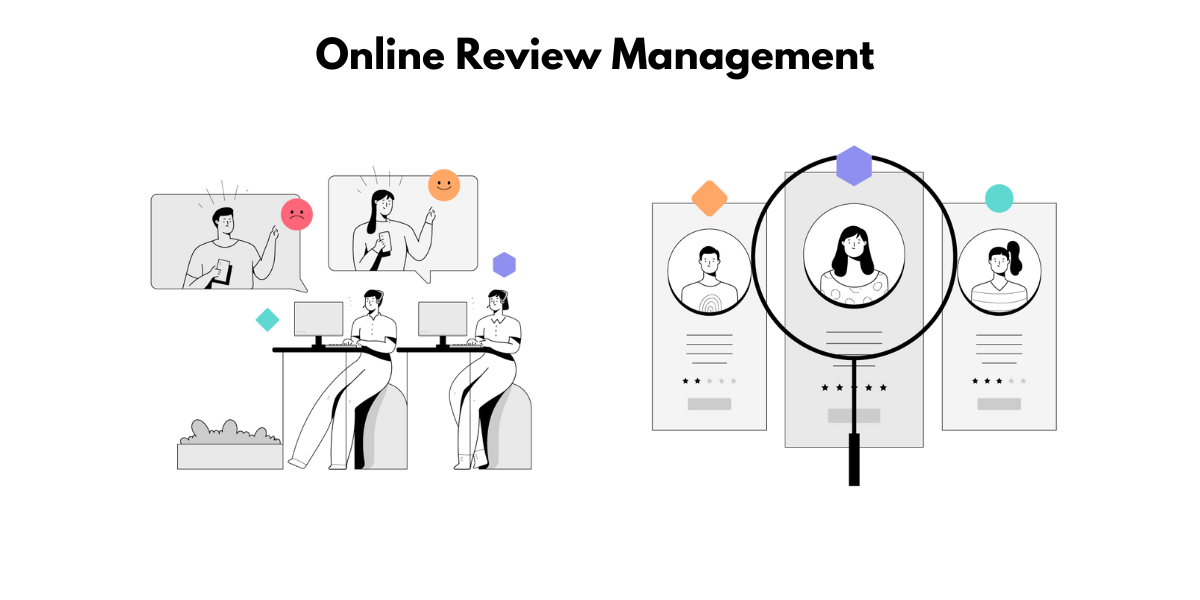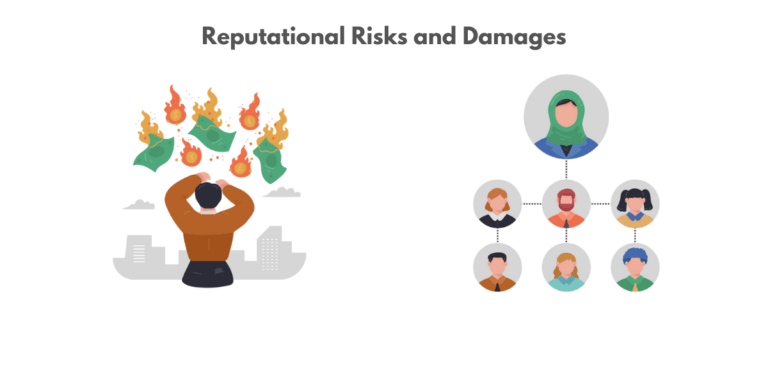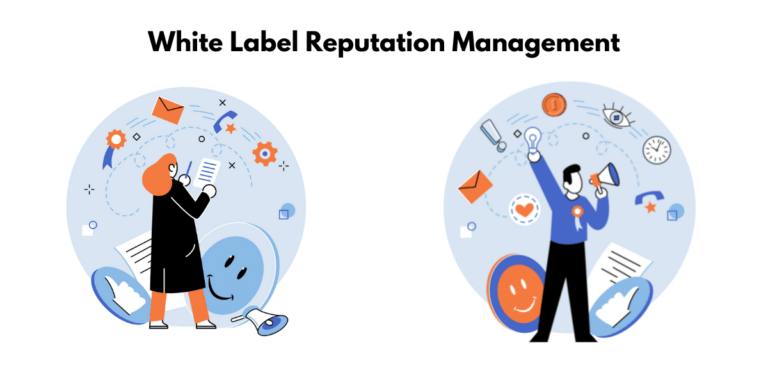Review Management for Marketing
With the prevalence of online reviews, customers can form opinions about a company before they even consider purchasing.
Businesses must pay attention to how they are perceived online to maintain a positive public image and protect their bottom line.
Review management software is a powerful tool that can help businesses collect, respond to, and generate reviews across multiple online review websites.
This software can help businesses to maintain their reputation, increase their local SEO rankings, and save time.
By implementing a review management strategy, businesses can ensure that their customers are happy and that their brand remains intact.
What is online review management?
Review management is the company process of monitoring, analyzing, responding to, and generating reviews across multiple online review websites.
It is used to support a company’s marketing strategy, improve overall performance, identify flaws in a business, and maintain a brand’s image.
Review management software helps businesses collect testimonials and reviews, respond to negative feedback, and improve customer perception of the product or service.
It can also remove certain reviews and increase a brand’s local SEO ranking.
Why is review management important?
Review management is an important part of a successful marketing strategy for businesses, as it helps build trust with consumers and be proactive regarding PR disasters.
Reviews can also allow businesses to identify operating flaws and inform their brand messaging and marketing strategies.
Review management can also improve online ratings and reviews, help protect and improve a business’s online reputation, increase its local SEO ranking, and save time.

How does local review management help businesses?
Review management helps businesses boost their reputation, increase their local SEO ranking, and save time by creating a streamlined communication process.
It also allows businesses to identify operating flaws and inform their brand messaging and marketing strategies.
Additionally, review management helps businesses by monitoring, analyzing, responding to, and generating reviews across multiple online review websites.
This is essential for maintaining a brand’s image, which directly affects sales, as research has found that 94 percent of consumers will avoid a company after reading a negative review.
Finally, review management improves online reviews and ratings and can also be used to remove certain kinds of reviews.
How do you manage reviews?
Review management is essential to any successful company marketing strategy, as a brand’s online reviews can directly affect customer trust and loyalty.
As online reviews become more and more prevalent, businesses need to develop a review management plan to maintain their brand’s image.
This plan should include tactics such as analyzing reviews for possible removal, monitoring reviews and ratings, and developing a strategy for responding to customer feedback.
By utilizing review management software, businesses can save time and money, improve their local SEO ranking, and build customer trust.
With the right review management plan, businesses can ensure their brand’s reputation remains strong, and their customers remain loyal.

Analyze review platforms
Start by analyzing the review platforms you want to improve, such as Google reviews and Yelp.
Look for any reviews that may violate their terms of service, as these can be removed.
Contact management
Set up a contact management system, either manual or using an API, to reach out to customers and ask them about their experience.
Ensure to include high-conversion messaging so customers can easily provide positive reviews.
Start a review management campaign
Once you have the contact management setup, you can start your review management campaign.
Try testing different messages to find the best one for your business.
Monitor and report reviews
Monitor your reviews and ratings to ensure they are improving.
Report on the progress and any improvements you’ve seen in the reviews and ratings.
Share reviews
Share your reviews on social media sites like Facebook, Twitter, and Instagram. Develop a sharing strategy and decide what ratings will be shared (e.g., 4 and 5 stars?).
You can also use reviews as marketing assets – include them on your website, proposal documents, and email signatures.

Promote reviews
Advertise your reviews on platforms like Google Ads, Facebook Ads, and the Google Display Network.
Identify internal and external sources that you can use to promote your reviews, such as opt-in and sales confirmation pages and product pages.
Finally, pair your reviews with irresistible offers or tripwires to increase engagement.
8 steps to implement review management
If you want to improve your online reputation and the number of reviews you get, implementing a review management strategy is a great place to start.
Review management actively responds to customer reviews, monitors review platforms, and improve your ratings on review sites.
With this beginner’s guide to review management, you’ll discover actionable strategies and approaches to help you get the most out of your efforts.
Step 1: Set review governance and processes
Review governance is an important part of review management as it helps businesses to protect and improve their online reputation.
It involves establishing policies and processes for monitoring customer reviews, responding to feedback, and maintaining the integrity and accuracy of reviews.
By developing a review governance strategy, businesses can ensure they take all necessary steps to manage their reviews and reputation effectively.
This includes responding quickly and appropriately to customer feedback, preventing spam and malicious reviews, and taking proactive measures to ensure the customer experience is positive.
Review governance helps businesses identify improvement areas and make changes to ensure customer satisfaction and loyalty.
Ultimately, review governance is essential to review management and helps businesses foster trust and build their reputation.
Step 2: Claim, set up, and optimize review site listings (if you’re starting from scratch)
If you’re starting from scratch and want to set up and optimize your review site listings, there are a few steps you should take.
First, you’ll want to claim and set up your listings on the mainstream sites, such as Google My Business, Facebook, Yelp, and BBB.
You can find detailed instructions for claiming each site and optimization tutorials for each.
Additionally, you should look into industry-specific and niche review profiles and set up and optimize those.
When optimizing your profile, make sure to include the following:
- Your NAP (name, address, and phone)
- Photos and videos
- Questions and answers
- Keywords and tags
- A description
- Hours of operation
- Website address
- Booking/appointment URLs
- Tracking details
- A call to action
Additionally, you should post content consistently on platforms like the following:
- Google My Business
- Yelp
- TripAdvisor
This will help build a relationship with your customers.

Step 3: Create a review lists audit spreadsheet
The first step to improving reviews is creating a review list audit spreadsheet.
This spreadsheet should contain all the details to effectively set up review management campaigns.
The spreadsheet should include the following items:
- Review platforms (Google reviews, Yelp, etc.)
- Reviews that need to be removed, manual or API-based contact management setup
- High-conversion messaging, target review platforms, messaging approval by the client
- Initiation of review management campaign, A/B testing
- Monitoring of reviews and ratings, reporting of reviews, and rating improvement
- Customer list in Excel or CSV format, text or email to customers
- Websites or platforms to send customers positive reviews
The review list audit spreadsheet should be used as a reference to initiate, monitor, and report on a review management campaign and ensure better reviews for customers.
Step 4: Monitor competitor/industry sentiment
Monitoring competitor/industry sentiment can help implement review management by giving businesses an understanding of the market as a whole and the specific areas that need improvement.
By regularly evaluating competitor sentiment and activity, businesses can identify areas where their products and services can stand out and take advantage of potential growth opportunities.
Additionally, by keeping track of competitor sentiment, businesses can develop strategies to better engage with customers, improve product offerings, and counter any negative sentiment.
Monitoring sentiment also helps businesses stay on top of industry trends to ensure their offerings are up-to-date and competitive.
This data can help businesses identify powerful ways to use review management to improve customer service and create better user experiences.
Step 5: Generate positive reviews using incentivized customer surveys
Incentivized customer surveys can be a powerful tool to generate positive reviews and improve overall review management.
The process uses a survey to ask customers how they feel about the product or service they received and offer incentives in exchange for reviews.
Step 6: Generate mixed reviews using incentivized customer surveys and qualitative reviews
Mixed reviews are neither overly positive nor overly negative but instead are somewhere in between, so they may contain some combination of positive and negative feedback.
They can help provide a more realistic and holistic impression of a product or service.
To incentivize customer surveys and qualitative reviews, businesses should provide customers with rewards and discounts for completing surveys and reviews.
This could be anything from a coupon for a future purchase, a restaurant gift card, or even a freebie item.
Additionally, businesses should ensure that the surveys and reviews are as easy to access and complete as possible.
This means providing customers with short, straightforward survey forms and clear directions on leaving reviews on their preferred platforms.

Step 7: Monitor the top review sites to identify high-impact content benchmark strategies
Monitoring the top review sites can be a great way to identify high-impact content benchmark strategies.
You can use various tools to help you monitor the sites, such as Google Alerts, Fanbooster, BoardReader, and Grade.us.
First, compile customer sentiment and competitor performance information with a monthly spreadsheet.
Include information about industry trends, customer expectations, and opportunities to outpace competitors.
You’ll also need to analyze the quantity and quality of reviews and the overall sentiment. Integrate your review management platform with Google to bring your data into the platform.
Lastly, track metrics like clickthrough rates, web traffic, opt-ins, conversions, aggregate review rating, return on ad spend, and revenue per review site visitor to understand your review portfolio.
With these steps, you can proactively identify high-impact content benchmark strategies.
Step 8: Optimize your strategies according to Step 3
Optimizing online review management strategies is important to maximize your team’s time, expand your unique selling points, and reach more potential customers.
With high ratings and multiple online reviews, Google is more likely to suggest your company to people making generic local searches.
Customers are 80 percent more likely to change their minds about a purchase when reviews are available.
Additionally, almost 10 percent of your ranking on the results page is influenced by your online review management and ratings on Google, Facebook, and other sites.
This can help you land on the first page of search results, or even the top three, for your selected keywords.
Investing in online review management also helps you to generate an impressive Net Promoter Score (NPS), which measures how likely consumers are to recommend you to a friend or colleague.
This can help you improve customer experience and reach more potential customers.

Review management software
Review management software is a set of tools and services that help businesses monitor and manage their online presence – particularly regarding customer reviews and mentions.
Its key features include monitoring the web for positive and negative reviews and allowing businesses to respond to negative reviews promptly.
It may also encourage positive reviews from satisfied customers.
Some advanced reputation management software can integrate with other systems, like customer relationship management (CRM).
As well as larger marketing software suites to help businesses maintain a strong and positive online profile.
Here are some examples of review management software you might want to look into and a table with basic info of the software to make it easy to compare.
| Tool | Price per Location | Review Monitoring | Review Generation | Review Widgets | White-Label Options | API |
|---|---|---|---|---|---|---|
| Reviewshake | $99/month | YES | YES | YES | NO | YES |
| Grade.us | $400/month | YES | YES | NO | YES | YES |
| Review Trackers | Available upon request | YES | YES | NO | YES | YES |
| Feedback Link | $69/month | YES | YES | YES | NO | NO |
| Reputation Brief | $39/month | YES | YES | YES | NO | NO |
| EmbedSocial | $99/month | YES | YES | YES | NO | NO |
| Reviewflowz | $50/month | YES | YES | YES | NO | NO |
| ReviewBot | $10/month | YES | YES | NO | NO | NO |
| Profile Rankings | $29/month | YES | YES | YES | NO | YES |
Reviewshake
Reviewshake is a reputation management platform designed to help businesses monitor customer satisfaction, collect feedback, and generate positive online reviews.
It offers custom review response writing to save businesses time and effort, allowing them to efficiently solicit customer feedback via email, text message, in-store kiosk, or even printable “review us” cards.
The tool integrates with every review site, focusing on the sites that matter most to the company and industry.
Grade.us
Grade.us is a reputation management software designed to help businesses collect, handle, and share clients’ reviews across corporate websites and social media platforms.
With Grade.us, businesses can track reviews on Google, Facebook, Yelp, and over 50+ other review sites.
It also helps automate getting reviews from clients, centralize all reviews at one platform, request reviews via email and SMS campaigns, and turn the best reviews into SEO-friendly web and social media content to build a business’s online reputation.
ReviewTrackers
ReviewTrackers is a review monitoring software for multi-location businesses that help businesses manage and generate online reviews, engage and respond to customer feedback, and discover key customer insights.
It empowers company locations to understand their customers better through advanced review and customer feedback technology.
The company solution allows for analyzing, amplifying, and maximizing insights to accelerate acquisition and improve retention while driving more authentic customer connections.
ReviewTrackers offers review management within a fully comprehensive platform.
Feedback Link
Feedback Link is the connection between reviews, likes, listings, comments, and clicks to your competitive advantage, allowing you to use customer feedback to improve your business.
With Feedback Link, you get an automated feedback loop that monitors and fixes broken links to review sites, guaranteeing the best chance that you won’t miss valuable reviews.
This data can be used to test out new processes, develop new designs, streamline feedback, understand the data, and take action to improve.
Reputation Brief
Reputation Brief is an online reputation management platform that allows businesses to analyze their online reviews, generate more reviews, monitor, and showcase positive reviews.
It also offers market research surveys, marketing campaigns, and other data from other sources to give businesses a comprehensive view of their online reputation.
With these tools, businesses can anticipate customer needs, build trust, and ultimately increase sales.
EmbedSocial
EmbedSocial is an all-in-one platform that allows businesses to collect, display, and share customer testimonials and reviews on autopilot.
With EmbedSocial’s automated tools, businesses can easily increase conversions, build customer loyalty, and strengthen their brand.
Over 5,000 businesses are already using EmbedSocial’s powerful testimonial automation tools, and you can sign up for a free trial to see the benefits for yourself.
Reviewflowz
ReviewFlowz is an online review management service that helps businesses stay organized, monitor customer feedback, and improve customer experience.
Their integration allows businesses to check in on their online review management conveniently.
It provides customers with a panoramic view of their entire online review flow–all on one interactive screen.
With ReviewFlowz, businesses can learn about their industry, create personalized email surveys, set up an email schedule, review results, and respond to negative reviews.
It is an effective tool that helps businesses boost their reputation, increase their local SEO ranking, and save time.
ReviewBot
ReviewBot is an automated customer review management platform that provides marketers, agencies, and businesses with powerful white label tools to track reviews on Google, Facebook, Yelp, and 50+ review sites.
It enables users to get client reviews, centralize reviews on one platform, request reviews via email and SMS campaigns, recover unhappy customers, and turn the best reviews into SEO-friendly web and social media content.
ReviewBot automates customers’ buying journey, allowing for streamlined communication and improved customer experiences.
It also includes features such as automated review alerts, complex filters, and the ability to fix broken links.
Profile Rankings
Profile Rankings is an online reputation management tool that makes it easy to customize and automate ratings and reviews from top sources like Google, Facebook, Yelp, Trip Advisor, Yellow Pages, Amazon, and more.
With their platform, you can compare performance and discover amazing opportunities for your brand.
Plus, their dashboard lets you view all your brand’s reviews in one place for more efficient performance tracking and optimization.
Their comprehensive reputation intelligence and insights help businesses and global brands assess how much trust people have in their brand.
They help make an informed decision on maintaining and increasing consumer trust.



![13 [Best] Brand Monitoring Tools and Software to Monitor Your Brands Growth](https://www.profilerankings.com/wp-content/uploads/2023/05/brand-monitoring-tools-768x384.png)



